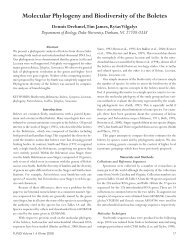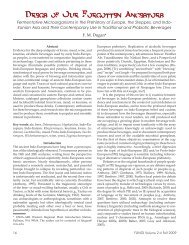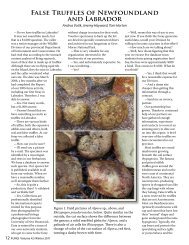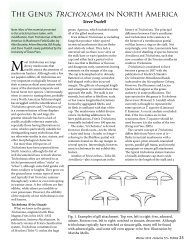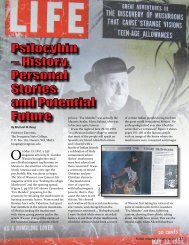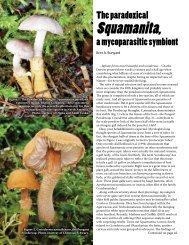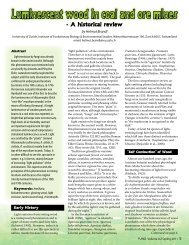Notes from Under- ground - FUNGI Magazine
Notes from Under- ground - FUNGI Magazine
Notes from Under- ground - FUNGI Magazine
You also want an ePaper? Increase the reach of your titles
YUMPU automatically turns print PDFs into web optimized ePapers that Google loves.
tanical microscopes and studying William Withering’s British Plants,<br />
and it is well-known that William Bartram’s Travels was a decisive<br />
influence on Coleridge’s poem “Kubla Khan.” “The Rime of the<br />
Ancient Mariner” incorporates several esoteric scientific influences:<br />
Joseph Priestley’s “Light <strong>from</strong> Putrescent Substances” <strong>from</strong><br />
his Opticks, among others. 11 Coleridge mythologized the eerie<br />
phenomenon of the phosphorescent sea as he gave voice to the<br />
mariner’s tale of death and disaster brought on by killing an albatross.<br />
Bioluminescence caused by teeming dinoflagellates and<br />
marine protozoa in ocean waters (a phenomenon later called “the<br />
burning of the sea”) was a fairly familiar marvel thanks to the<br />
reports of Captain James Cook, William Dampier, and other seafarers.<br />
These appearances took on the form of artificial fire, shiny<br />
trails of milk, starry skies, and even slime. In “The Rime of the<br />
Ancient Mariner,” the mystery of the sea and the properties of<br />
oceanic bioluminescence coalesced in a monstrous image of rot<br />
and slime:<br />
The very deep did rot: O Christ!<br />
That ever this should be!<br />
Yea, slimy things did crawl with legs<br />
Upon the slimy sea. 12<br />
The image of a rotting sea teeming with untold animalculae conjoins<br />
the supernatural and the fungal as it burns “green, and blue<br />
and white.” Appropriately, Thomas Carlyle described Coleridge<br />
himself as “a mass of richest spices putrefied into a dunghill,” a<br />
fitting metaphor for a mushroom that neatly summarized the contradictions<br />
of the poet. 13<br />
The mushroom that appears in Lewis Carroll’s Alice’s Adventures<br />
in Wonderland (1865) is arguably the best-known mushroom<br />
in the western literary tradition. The controversy and mystery<br />
surrounding Carroll’s mycological knowledge is therefore proportionally<br />
large, and this is significant, given that the mushroom<br />
was the size of Alice herself. That is to say, it was the size of a<br />
mushroom, for Alice had shrunken considerably. In a fantasy world<br />
where size and proportion are<br />
called into question at every turn,<br />
it seems a surprise that Carroll<br />
presented the mushroom itself as<br />
so matter-of-factly ordinary, for in<br />
the original illustration by John<br />
Tenniel it looks utterly unremarkable.<br />
Is it possibly a tricholoma?<br />
The very question indicates the<br />
naturalist’s strong desire “to put a<br />
name on the thing,” forgetting en-<br />
John Tenniel illustration for<br />
Lewis Carroll’s Alice’s<br />
Adventures in Wonderland, 1865.<br />
tirely that we are in Wonderland.<br />
What is this mushroom? And why<br />
do we need to know? Carroll and<br />
Tenniel offer the reader no more than wonderland associations: a<br />
talking caterpillar languidly puffing on a hookah and the<br />
mushroom’s ability, once eaten, to alter size and proportion. These<br />
two clues have led several to speculate that the Wonderland mushroom<br />
is an hallucinogenic fungus; more specifically, that it is Amanita<br />
muscaria. The infamous fly agaric rears its superpotent pileus<br />
here thanks first to Robert Gordon Wasson’s “mushroomic” speculations<br />
in Mushrooms, Russia, and History. Fly agaric is unquestionably<br />
the most abundant and easily recognized mushroom in all<br />
the world of fantasy and folklore, and its bright red cap with white<br />
spots has become a fairytale cliché. Wasson, constantly sifting for<br />
evidence for his beloved soma through the pages of history and<br />
literature, and often reaching conclusions that are as suspect as<br />
they are tantalizing, hypothesized that Carroll, if not directly influenced<br />
by Mordecai Cubitt Cooke, the British mycologist, may<br />
have read a review of Cooke’s A Plain and Easy Account of British<br />
Fungi (1862) in The Gardeners’ Chronicle and Agricultural Gazette.<br />
Wasson springs to an inevitable Q.E.D.:<br />
With a shout of discovery we leap to the conclusion that<br />
Alice’s mushroom is the one that Cooke serves us [Amanita<br />
muscaria]. The timing is perfect. Surely the progenitor<br />
of Alice, in the cloistered retreat of Christ Church,<br />
with Cooke’s manual at hand, transmuted the untamed<br />
practices of the uncivilized Korjaks into the poetry of<br />
wonderland. 14<br />
But why place real toadstools in imaginary gardens? For the common<br />
reason that the metaphoric valence of strangeness in a mushroom<br />
that causes perceptual distortions propels us forward with<br />
an inexorable taxonomic imperative as it sparks us with the need<br />
to explain. Richard Evans Schultes, the magisterial authority on<br />
plant hallucinogens, also entertained a close connection between<br />
Cooke’s Seven Sisters of Sleep (1860) and Lewis Carroll’s mycology<br />
but wisely advised “we have absolutely no proof ” of this. Terence<br />
McKenna, in The Archaic Revival (1991) helps to clarify Wasson’s<br />
speculations a bit, and Elio Schaechter suggests “there is evidence<br />
that Lewis Carroll was well-informed about the hallucinogenic<br />
power of mushrooms,” and offers a key bit of evidence that Carroll<br />
first described Alice as eating separately <strong>from</strong> mushroom cap and<br />
stem (producing the differing effects) in the earlier Alice’s Adventures<br />
<strong>Under</strong><strong>ground</strong>. 15 In all of this, no one has bothered to examine<br />
the illustrations, and these are rife. Carroll himself and Tenniel<br />
created the first illustrations; Arthur Rackham illustrated a famous<br />
edition of Alice in 1907; an Italian edition in 1953 depicted<br />
an elf-like caterpillar atop a lepiota-like mushroom; and the Walt<br />
Disney LP recording of 1944 featured a saucy, smiling Ginger<br />
Rogers with arms akimbo under a massive lavender mushroom<br />
with a long, grumpy face on its stipe. There are many, many more.<br />
The genesis of John Tenniel’s drawings in the first edition of Alice<br />
24 <strong>FUNGI</strong> Volume 2:1 Spring 2009



